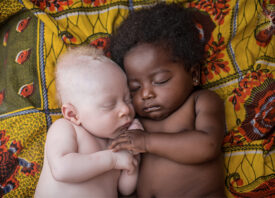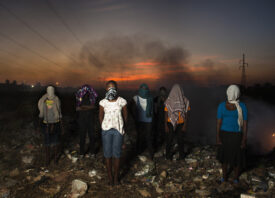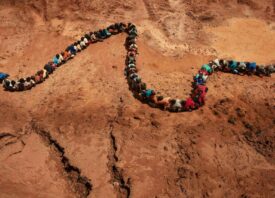Search this site
Self Portraits by Senegalese Photographer Omar Victor Diop Recreate Historic Paintings

Omar Victor Diop, Don Miguel de Castro, Emissary of Congo (c. 1643-50)
From the series: Project Diaspora 2014
Pigment inkjet print on Harman Hahnemuhle paper 47 1/4 x 31 1/2 in. Edition of 8 + 2 APs
In 1643 or 1644, Don Miguel de Castro and two servants arrived as part of a delegation sent by the ruler of Sonho, a province of Congo, via Brazil to the Netherlands. One objective of the journey was to find a resolution to an internal conflict in Congo. Original painting attributed to Jaspar Beck or Albert Eckout.

Omar Victor Diop, A Moroccan man (1913)
From the series: Project Diaspora 2014
Pigment inkjet print on Harman Hahnemuhle paper 47 1/4 x 31 1/2 in. Edition of 8 + 2 APs
Jose Tapiro y Baro was a Catalan painter. One of his closest friends was the painter Maria? Fortuny with whom he shared an interest for Orientalism. He was a master of watercolor painting. Original Painting by Jose? Tapiro y Baro.
The great African proverb wisely observes, “Until the lions have their historians, tales of the hunt shall always glorify the hunter.”
The lion has arrived in the form of Omar Victor Diop, a rising star in the photography world. Born 1980, in Dakar, Senegal, Diop has inherited the great traditions of African studio photography and takes them to the next level in his new exhibition, Project Diaspora, currently on view at SCAD FASH Museum of Fashion + Film in Atlanta, GA, through August 18, 2017.
In Project Diaspora, Diop tells the story of the lions of African history through the recreation of historic portrait paintings of key figures in art, politics, theology, and trade living between the 15th and the 19th centuries. This particular period reveals the complex relationship between African and the rest of the world, as European imperialist forces ransacked the continent, enslaving its people, occupying its lands, and looting its natural resources.
As a result, the history of the African people extends far beyond the continent as the diaspora takes hold. Millions of people are captured, enslaved, and sold to foreign imperialists who seized North and South Americas. At the same time, the peoples who remained on the continent were forced to deal with what the invaders wrought, their lives and history disrupted and often times destroyed by the inhumanity practiced by those who claimed to live in “The Age of Reason.”
For Project Diaspora, Diop skillfully assumes the mantle of photographer and model, costume designer and stylist, casting himself in a series of 18 historic portraits that honor the lions of the past including American activist and writer Frederick Douglass (1818-1895); Venezuelan soldier Pedro Camejo (1790-1821), lieutenant to Simon Bolivar; Juan de Pareja (1606-1670), Spanish painter and assistant to Diego Velazquez; Italian Franciscan Moor St. Benedict of Palermo (1526-1589), who was canonized in 1807; and Dom Nicolau (1830-18600, prince of Congo and perhaps the earliest African leader to protest imperial occupation.
Each portrait is a study in beauty, power, and pride, a personal history and a public record of the stories that go untold in favor of propaganda that is numbs the mind, dulls the senses, and fosters disgrace. The diversity of the subjects, of their eras and milieus, of their expertise and their wisdom, speaks power to truth. Here we see the genius of Africans from all walks of life, whether they are born on the continent or anywhere else on earth.
By recasting historic works as photographs, Diop not only honors the legacies of these great men but he also pays homage to artists of the past. We see the many styles of painting and the way in which the portrait is crafted to withstand the test of time while creating a psychological portrayal of a singular individual. Perhaps that is why it is easy to forget that the men in Diop’s photographs all share the same face. He embodies their spirits so beautifully that he goes beyond being a model, and becomes an actor channeling the heroic visages of history.
Hung on royal blue walls, Project Diaspora comes alive, a tribute to not just the past, but to the present and future of mankind. In telling these stories, we are reminded that history is written by the victors—and the game isn’t over yet.

Omar Victor Diop, Dom Nicolau (Circa. 1830-1860)
From the series: Project Diaspora 2014
Pigment inkjet print on Harman Hahnemuhle paper 47 1/4 x 31 1/2 in. Edition of 8 + 2 APs
Dom Nicolau, prince of Kongo is perhaps the earliest African leader who wrote publicly to protest colonial influences. Nicolau, protested against Portuguese commercial and political activity and military expansion by publishing a letter in a Portuguese newspaper in Lisbon. His exact birth date remains uncertain. Contemporary engravings of Nicolas during his visit in Lisbon in 1845 suggest that he was then perhaps fifteen to twenty years of age. Original engraving: Unknown artist.

Omar Victor Diop, Jean-Baptiste Belley (1746 – 1805)
From the series: Project Diaspora 2014
Pigment inkjet print on Harman Hahnemuhle paper 47 1/4 x 31 1/2 in. Edition of 8 + 2 APs
Jean-Baptiste Belley was a native of Senegal, born on the Island of Gore?e and former slave from Saint-Domingue in the French West Indies who bought his freedom with his savings. During the period of the French Revolution, he became a member of the National Convention and the Council of Five Hundred of France. He was also known as Mars. Original painting by Girodet.
Courtesy of the artist and Galerie MAGNIN-A, Paris, France

Omar Victor Diop: Project Diaspora. Photography by Justin Chan.

Omar Victor Diop, Juan de Pareja (1606 – 1670)
From the series: Project Diaspora 2014
Pigment inkjet print on Harman Hahnemuhle paper 47 1/4 x 31 1/2 in. Edition of 8 + 2 APs
Juan de Pareja was a Spanish painter, born in Antequera, near Ma?laga, Spain. He is primarily known as a member of the household and workshop of painter Diego Vela?zquez. He later became Velazquez’s assistant sometime after the master returned to Madrid from his first trip to Italy in January 1631. Original Painting by Diego Velasquez
Courtesy of the artist and Galerie MAGNIN-A, Paris, France

Omar Victor Diop, Frederick Douglass (1818-1895)
From the series: Project Diaspora 2014
Pigment inkjet print on Harman Hahnemuhle paper, 47 1/4 x 31 1/2 in. Edition of 8 + 2 APs
Frederick Douglass was a social reform activist, writer, and statesman. He escaped from slavery, and later became a leader of the abolitionist movement, renowned for his impressive oratory and writing. His experiences as a slave have been narrated in several autobiographies which became bestsellers. He is also remembered for being the first African American nominated for Vice President of the United States. Original portrait by: Samuel J. Miller.

Omar Victor Diop, Malick Ambar (1549-1626)
From the series: Project Diaspora 2014
Pigment inkjet print on Harman Hahnemuhle paper 47 1/4 x 31 1/2 in. Edition of 8 + 2 APs
Malik Ambar was an Ethiopian born in Harar, sold as a child by his parents due to poverty. He was eventually brought to India. He eventually rose to become a very popular Prime Minister of the Ahmadnagar Sultanate, showing his administrative acumen in various fields. Malik is also regarded as a pioneer in Guerilla warfare in the Deccan region. He is a figure of veneration to the Siddis of Gujarat
Courtesy of the artist and Galerie MAGNIN-A, Paris, France

Omar Victor Diop: Project Diaspora. Photography by Justin Chan.

Omar Victor Diop, Pedro Camejo (1790-1821)
From the series: Project Diaspora 2014
Pigment inkjet print on Harman Hahnemuhle paper 47 1/4 x 31 1/2 in. Edition of 8 + 2 APs
Pedro Camejo, better known as «Negro Primero», or ‘The First Black’ was a Venezuelan soldier who fought with the rebel army during the Venezuelan War of Independence, reaching the rank of lieutenant. He was nicknamed «El Negro Primero» because he was always at the forefront of every battle. He was also to the only black officer in the army of Simon Boli?var
Courtesy of the artist and Galerie MAGNIN-A, Paris, France

Omar Victor Diop, Albert Badin (1747 or 1750 – 1822)
From the series: Project Diaspora 2014
Pigment inkjet print on Harman Hahnemuhle paper 47 1/4 x 31 1/2 in. Edition of 8 + 2 APs
Adolf Ludvig Gustav Fredrik Albert Badin, ne?e Couchi, known as Badin, was a Swedish court servant and diarist, originally a slave, butler of first Queen Louisa Ulrika of Prussia and then Princess Sophia Albertine of Sweden. His original name was Couchi, but he was commonly known as Badin, which means mischief-maker or trickster. Original Painting by Gustaf Lundberg.

Omar Victor Diop: Project Diaspora. Photography by Justin Chan.
All images: © Omar Victor Diop. Courtesy of the artist and Galerie MAGNIN-A, Paris, France.



